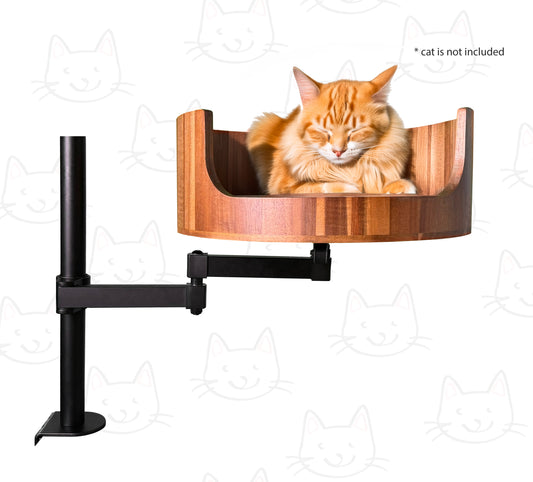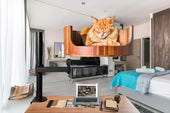
When a Cat Wags Their Tail: Understanding Feline Behavior
Share
Ever wonder what your cat is trying to tell you when they wag their tail? Understanding feline behavior can be a complex and intriguing topic for cat owners. Desk Cat Nest is a popular online platform dedicated to providing guidance on various aspects of cat care, including decoding your cat's body language and behaviors. In this article, we will delve into the fascinating world of cats and their tail wagging behavior.
Cats communicate through various signals, including vocalizations, body language, and tail movements. Tail wagging is one of the ways cats express their emotions and intentions. Contrary to popular belief, a cat wagging their tail does not always signify happiness or contentment. In fact, it can indicate a range of emotions such as agitation, frustration, or even aggression. By learning to interpret your cat's tail wagging, you can better understand their feelings and respond accordingly to ensure a harmonious relationship between you and your feline companion. Stay tuned as we explore the nuanced meanings behind a cat's wagging tail and gain valuable insights into your pet's behavior.
1. Cats wag their tails as a form of communication, expressing a range of emotions such as excitement, frustration, or aggression.
2. Understanding the context in which a cat is wagging its tail is key to deciphering its true meaning.
3. Rapid tail wagging can indicate a cat is feeling agitated or on the verge of aggression, while slow swishing may signal contentment.
4. It is important to pay attention to other body language cues when interpreting a cat's tail wagging behavior.
5. Building a strong bond with your feline companion through observation and response to their tail movements can enhance your relationship and communication with them.
Understanding Feline Tail Language
Feline tail language is a crucial aspect of understanding cat behavior. Cats use their tails to communicate various emotions and moods. When a cat wags their tail, it can indicate different meanings depending on the speed and position of the wagging. For example, a slow and subtle tail wag may indicate that the cat is curious or content, while a fast and aggressive tail wag may signal agitation or aggression.
Reasons Behind Tail Wagging
There are several reasons why a cat may wag their tail. One common reason is excitement or anticipation, such as when a cat is waiting for their favorite treat or toy. Tail wagging can also occur during playtime, as cats use their tails to show their enthusiasm. However, tail wagging can also be a sign of stress or discomfort, especially if it is accompanied by other body language cues like flattened ears or dilated pupils.
Reading Body Language Along with Tail Wagging
To fully understand a cat's behavior, it is essential to consider their tail wagging in conjunction with other body language cues. Cats communicate through a combination of tail movement, ear position, vocalizations, and facial expressions. For example, a cat with an upright tail, relaxed ears, and soft eyes is likely feeling content and friendly. On the other hand, a cat with a low or puffed-up tail, flattened ears, and dilated pupils may be feeling fearful or aggressive.
Seeking Professional Help for Behavioral Concerns
If a cat's tail wagging behavior is causing concern or if it is accompanied by other worrisome behaviors, it may be time to seek professional help. A veterinarian or animal behaviorist can provide valuable insights into your cat's behavior and help address any underlying issues that may be causing distress. By taking proactive steps to understand and address your cat's behavior, you can ensure a happy and healthy relationship with your feline friend.
## FAQ
### Is the Desk Cat Nest large enough for my cat to comfortably wag their tail?
Yes, the Desk Cat Nest is designed to provide ample space for your cat to move around and wag their tail freely. The spacious design ensures that your cat will have enough room to stretch and move comfortably while inside the nest.
### Will the Desk Cat Nest provide a safe and secure environment for my cat when they wag their tail?
Yes, the Desk Cat Nest is made with durable and sturdy materials to ensure the safety and security of your cat. The enclosed design of the nest provides a cozy and protected space for your cat to wag their tail without any risk of injury or discomfort.
### Can I easily clean the Desk Cat Nest if my cat wags their tail and leaves fur behind?
Yes, the Desk Cat Nest features a removable and washable cushion for easy cleaning. Simply remove the cushion from the nest and machine wash it according to the care instructions provided. This will help you keep the nest clean and fresh for your cat to enjoy.
### Will my cat enjoy using the Desk Cat Nest when they wag their tail?
Most cats love the cozy and enclosed feeling of nest-style beds, making the Desk Cat Nest a popular choice for feline companions. The soft cushion and secure design create a comfortable and inviting space for your cat to relax, play, and wag their tail to their heart's content.
In conclusion, providing your cat with a comfortable and secure space like the Desk Cat Bed can help alleviate stress and anxiety, leading to reduced tail wagging behavior. With its plush cushioning and enclosed design, this bed offers a cozy retreat for your feline friend to relax and unwind. By choosing the Desk Cat Bed, you are not only investing in your cat's well-being but also promoting a healthier and happier environment for both you and your pet.



















































